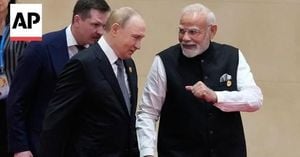Interest rate decisions by central banks worldwide continue to signal caution and responsiveness to shifting economic conditions. Recent moves by the Hungarian National Bank, the European Central Bank (ECB), the US Federal Reserve, and the State Bank of Pakistan highlight the delicate balance these institutions face amid rising inflation and economic uncertainties.
The Hungarian National Bank (MNB) has opted to maintain its key interest rate at 6.5%, marking the fourth consecutive meeting at which the rate remains unchanged. This decision reflects the MNB’s cautious approach to monetary easing as inflation concerns loom large. Vice-Governor Virag of the MNB expressed the seriousness of current economic signals, stating, “We will continue to adopt a cautious approach to monetary easing.” This persistent inflation, which rose from 3.2% year-on-year to 3.7% by November and peaked at 4.7% by December, has compelled the bank to keep the rate steady, with analysts predicting continued rate freezes through at least mid-2025.
Meanwhile, the ECB faces mounting pressure to adjust its rates amid rising industrial crises within the Eurozone. Economists anticipate the ECB is likely to implement another 0.25% cut to the deposit facility rate during its January meeting. Eric Dor, Director of Economic Studies at IESEG School of Management, strongly believes the ECB will proceed with this cut, asserting, “The ECB will almost certainly proceed with another 0.25% cut to the rates this week.” This change would see the rate reduced to 2.75%, hinting at the ECB’s response to dwindling growth forecasts and persistent inflationary pressures.
Yet, the current economic narrative remains one of uncertainty, with Dor noting risks related to inflation and growth. “There is always the risk of inflation rebounding if labor or energy costs rise significantly, but we must also recognize potential pitfalls if real activity deteriorates, which could drag average inflation below the target of 2%,” he cautioned.
Pimco’s portfolio manager, Konstantin Veit, echoed similar sentiments, stating, “We believe the ECB will reduce the deposit facility rate by 25 basis points.” He highlighted the bank’s need to navigate inflation, which, albeit on the rise, emphasizes the level of concern around sustainable growth rates within the zone.
Across the Atlantic, the Federal Reserve is maintaining its key interest rate at around 4.3%, following three successive cuts from its two-decade high of 5.3%. Despite speculations about the necessity for continued cuts, Jerome Powell, the Fed's chair, has indicated the institution’s preference to evaluate incoming economic indicators before proceeding with additional rate adjustments. According to former economist Vincent Reinhart, Powell understands the dynamics of maintaining independence against external political pressures. “If you like your independence, then you have to live with the criticism,” he reminded stakeholders, hinting at the continuing struggle between regulatory policy and market pressures.
President Donald Trump has vocalized his desire for lower rates, adding to the complex environment the Fed operates within. The officials are now hesitant, striving to keep borrowing costs sufficiently high to control inflation without stalling economic growth altogether. Economic indicators such as low unemployment rates and varied inflation reports will guide their decisions moving forward.
On the global front, the State Bank of Pakistan has reduced its key rate by 100 basis points to 12%, reflecting its strategy to rejuvenate the economy bolstered by declining inflation rates, which have reached their lowest levels since mid-2024. A spokesperson for the State Bank noted, “The State Bank of Pakistan has reduced its rate by 100 basis points to 12%,” capturing the aggressive nature of recent monetary policy adjustments within Pakistan’s economic framework as it navigates through post-pandemic recovery.
The shifts by these banks highlight the interconnectedness of global economies and the shared challenges they face due to inflation, growth stagnation, and the looming specter of political instability affecting markets worldwide. These dynamic and sometimes reactive monetary policies showcase the balancing act central banks must navigate to achieve sustainable growth and maintain price stability.
With economic indicators fluctuated by global events, the forthcoming meetings of these central banks will likely shed light on whether trends observed will continue or if new strategies will emerge as policymakers respond to the continually shifting economic landscapes they face.



